''Plasma Crystal''
News (2011)
|
December 2011
|
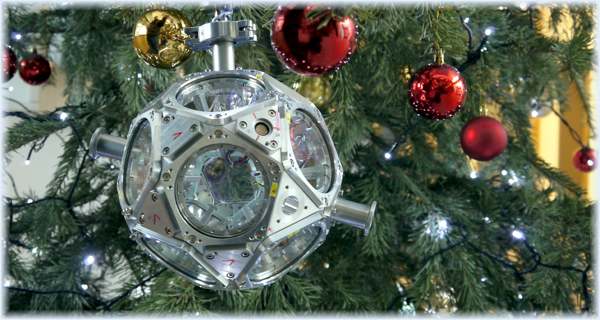
(Image courtesy of Uwe Konopka)
Merry Christmas and a Happy New Year!
The ''big Christmas tree ball'' is our
PlasmaLab chamber, developed by Uwe Konopka
and built by our MPE workshop.
Thank you all very much.
G.M.
|
October 2011
|
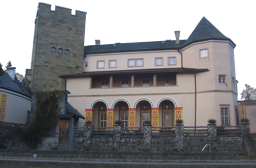
Ringberg Castle above Lake Tegernsee,
a meeting place of the Max Planck Soc.
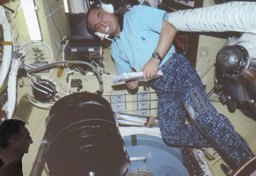
Cosmonaut Alexander Skvortsov with
PK-3 Plus aboard the space station ISS
(Photos: MK)
|
Cosmonaut Castle: PK symposium at Ringberg
The annual Plasma-Kristall symposium of the the MPE theory group
with this year's subtitle ''10 years of complex plasmas on the ISS''
was held at  Ringberg
Castle high above lake Tegernsee in the Bavarian Alps. MPE staff
members, colleagues from Moscow, and representants of the companies
Kayser-Threde (Munich) and Roskosmos (Moscow) climbed to the meeting
center of the Max Planck Society south of Munich. Invited guests were
also the Russian cosmonauts Ringberg
Castle high above lake Tegernsee in the Bavarian Alps. MPE staff
members, colleagues from Moscow, and representants of the companies
Kayser-Threde (Munich) and Roskosmos (Moscow) climbed to the meeting
center of the Max Planck Society south of Munich. Invited guests were
also the Russian cosmonauts
 Yuri
Baturin, Yuri
Baturin,  Oleg
Kotov and Oleg
Kotov and  Alexander Skvortsov. They all operated our
Plasma-Kristall experiment facility PK-3 Plus aboard the
International Space Station ISS. Alexander Skvortsov. They all operated our
Plasma-Kristall experiment facility PK-3 Plus aboard the
International Space Station ISS.
Three days in the castle's large meeting room were dedicated to
the exchange of experiences, results and news concerning the
Plasma-Kristall experiment. Alexander Skvortsov (image left side)
reported on his long-term stay onboard the orbital complex and
gave an impression of his artistic images of planet Earth from
space. A 'Bavarian evening' completed the meeting and enhanced
the contact between Russian and German colleagues.
Download the symposium's agenda:
PDF
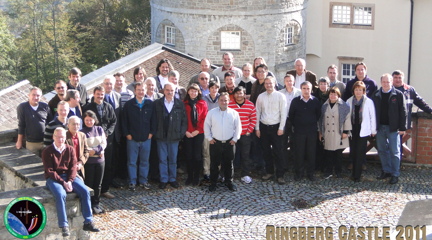
Enlarge:
group photo 1,
group photo 2.
|
September 2011
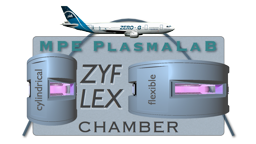
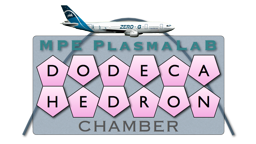
|
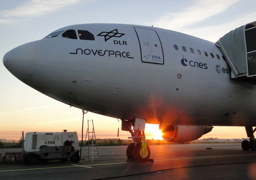
Airbus A300 ZERO-G (Photo ©MK)




MPE parabolic flight crews in Bordeaux
and visitors lining up to see the ZERO-G
during the aerospace day in Cologne.
(Photos: AL, MK, UK. Click to enlarge.)
|
MPE PlasmaLab on board the Airbus A300 ZERO-G
The MPE project 'PlasmaLab' was elected to take part in a parabolic flight
campaign conducted by the German Aerospace Center DLR for the second time.
Three days were available for micro-gravity research in Bordeaux and two
days in Cologne where the Airbus A300 ZERO-G - together with our PlasmaLab
setup - was on display during the aerospace day at the Köln-Bonn
airport. Six MPE staff members and one colleague from our partner institute
JIHT in Moscow took part in the campaign and made plasma experiments in
weightlessness.
Two plasma chambers and a new radio-frequency generator have been on board:
The Zyflex chamber ist eine cylindrical plasma chamber
with flexible geometry where the distance of the electrodes
can be changed during operation. Also the electrodes can be changed
very easily, for example plate and mesh electrodes. This offers a wide
range of experiments in a large parameter space.
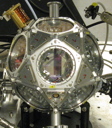 Also inside the PlasmaLab setup was the Dodecahedron, a chamber
with a totally new design. Twelve electrodes in a soccer ball-like structure
form a spherical system to create an isotropic plasma. This chamber was
built into the parabolic flight rack but could not be fully operated yet.
But the new RF generator designed for that chamber could be tested
sucessfully with the Zyflex chamber.
Also inside the PlasmaLab setup was the Dodecahedron, a chamber
with a totally new design. Twelve electrodes in a soccer ball-like structure
form a spherical system to create an isotropic plasma. This chamber was
built into the parabolic flight rack but could not be fully operated yet.
But the new RF generator designed for that chamber could be tested
sucessfully with the Zyflex chamber.
In the near future PlasmaLab is to continue the successful story of
MPE's plasma chamber facilities aboard the ISS:
PKE-Nefedov, PK-3 Plus and PK-4.
The development of PlasmaLab is supported by the German Aerospace
Center (DLR).
More on this campaign in the German media:
|
July 2011
|
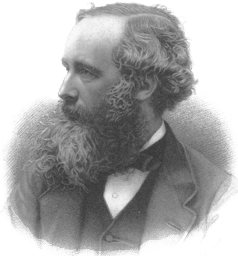
James Clerk Maxwell
(1831-1879)
|
James Clerk Maxwell Prize for Gregor Morfill
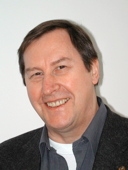 Every year the American Physical Society (APS) awards outstanding
contributions to the field of plasma physics with a prize.
In 2011 this prize was given for the first time to a German
physicist and for the first time to the field of complex plasmas.
The recipient is Prof. Gregor Morfill, Max Planck Director and head
of the 'Theory/Complex Plasmas' group of MPE.
Every year the American Physical Society (APS) awards outstanding
contributions to the field of plasma physics with a prize.
In 2011 this prize was given for the first time to a German
physicist and for the first time to the field of complex plasmas.
The recipient is Prof. Gregor Morfill, Max Planck Director and head
of the 'Theory/Complex Plasmas' group of MPE.
The APS honors the outstanding work of Prof. Morfill in the field of
dusty and complex plasmas: The discovery of plasma crystals, his work
on the structure of Saturn's rings, and the ongoing research of complex
plasmas on board the International Space Station ISS which condensed
into 500+ publications in scientific journals. Morfill dedicates himself
to theoretical astrophysics, as well as to a totally new application of
plasma physics:
Plasma Health Care.
The prize is given since 1975 by the APS in honor of the scottish physicist
 James
Clerk Maxwell (1831 - 1879) who found the fundamental equations
to describe electro-magnetic waves. The prize consists of a certificate
and a prize money. It is presented during an APS meeting in November
in the US where the recipient is invited to. James
Clerk Maxwell (1831 - 1879) who found the fundamental equations
to describe electro-magnetic waves. The prize consists of a certificate
and a prize money. It is presented during an APS meeting in November
in the US where the recipient is invited to.
See also:  APS
website APS
website
Congratulations!
|
May 2011
|
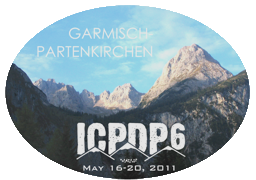
ICPDP6 logo © TH/MK/MPE
|
MPE theory group to host ICPDP6 in Garmisch-Partenkirchen
The sixth International Conference on Physics of Dusty (complex) Plasmas
was organized this time by the theory group of MPE who was involved in the
discovery of crystaline structures in such plasmas in 1994. More than 200
plasma physicists from all over the world found their way to
Garmisch-Partenkirchen (Bavaria, Germany) to present their latest
results on the foot of Germany's highest mountain, the Zugspitze (2962m).
50 oral and more than 200 poster presentations in 3 sessions drew the
participant's attention, probably not only due to the free beer.
Two more social events offered the opportunity to improve contacts to
the international colleagues: An excursion to the Ettal monastery
and to Linderhof Castle, one of King Ludwig II.'s famous buildings
situated nearby Germisch. A 'Bavarian evening' took place during the
conference dinner, offering local food and music. Physicists could be
seen dancing until the early morning!
The next ICPDP will be held in 2014 in Delhi, India. Previous conference
sites were Orléans (France, 2005) and Ponta Delgada (Azores, 2008).
More Informationen:
Agenda,
list of talks (pdf),
liste of posters (pdf),
website,
photos.
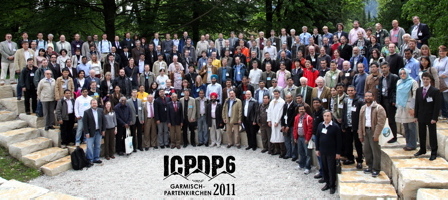
Group photo (Courtesy of A. Semenov. Click to enlarge)
|
March 2011
|
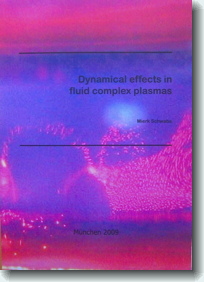
''Dynamical effects in fluid complex
plasmas'', Dissertation of
Dr. Mierk Schwabe (Munich 2009)
|
Dissertation on complex plasmas awarded with EPS prize
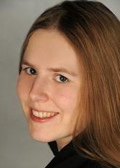
Dr. Mierk Schwabe who did her PhD thesis in the Theory/Complex Plasma
group of MPE has been given a special honor. Her dissertation titled
''Dynamical effects in fluid complex plasmas'' has been awarded with the
PhD prize of the Plasma Physics Section of the European Physical Society (EPS).
This prize honors outstanding achievements in plasma physics of young
researchers during their PhD work.
The prize will be presented during the annual convention of the Plasma
Physics Section. It includes a prize money, a three-year free membership in
the EPS and the opportunity to present the work at the convention to take
place in the city of Strasbourg in France this year.
Dr. Schwabe studied complex plasmas in her PhD work. These are ionized gases
containing micron-sized spherical particles. She investigated effects
that can be also observed in normal liquids, e.g. the propagation of
waves and the formation of droplets and bubbles. There she could show
that also a small amount of particles (~thousands) behaves like a liquid
which scales to a few nanometers in a regular liquid like water. This is
an important step towards the understanding of the behavior of nanofluids.
More:  Download
dissertation Download
dissertation
|
February 2011
|
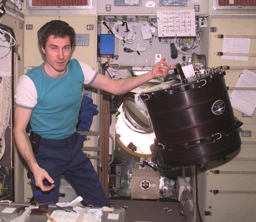
Cosmonaut Sergey Krikalev with the
plasma crystal experiment PKE-Nefedov
onboard the space station ISS (March 2001)
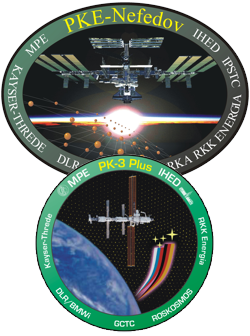
10 years of complex plasma research
onboard the ISS
|
10 years plasma crystals in space
This is the year 2001. On February 28 the Russian cargo spacecraft
M-44 docks with the International Space Station at this time made up
by the Russian core modules Zarya and Zwesda and the American Unity
module. The first permanent crew
 ''Expedition 1'' consisting of William Sheperd,
Sergey Krikalev and Yuri Gidzenko. With Progress M-44 the first
plasma crystal experiment facility developped by MPE and ''Expedition 1'' consisting of William Sheperd,
Sergey Krikalev and Yuri Gidzenko. With Progress M-44 the first
plasma crystal experiment facility developped by MPE and
 IHED, named
''PKE-Nefedov'', comes to the orbial station. On March 3 the device
is unpacked from the Progress and operated for the first time. (See
picture, left) – the beginning of the successful story of complex
plasma research in space. IHED, named
''PKE-Nefedov'', comes to the orbial station. On March 3 the device
is unpacked from the Progress and operated for the first time. (See
picture, left) – the beginning of the successful story of complex
plasma research in space.
Complex plasmas are made of micron-sized plastic spheres inside a
low-temperature plasma
(produced by an electrical high frequency discharge
in Argon gas at low pressure) that are electrically charged and thus interact
with each other. Under certain conditions the particles arrange in a
regular way forming a plasma crystal. On Earth this process is
disturbed by gravity, but in weightlessness large crystals can be grown.
This is why plasma crystal experiments are performed preferably in space.
In the past 10 years plasma crystal experiments of MPE and IHED (now: JIHT)
were performed successfully onboard the ISS, first with ''PKE-Nefedov''
(2001-2005), then with ''PK-3 Plus'' (since 2006) in totally 27 missions on
85 days (with 90 minutes experiment time each) by 23 cosmonauts. This makes
the plasma crystal facilities to the mostly used scientific experiments onboard
the ISS. The results were published in numerous articles in refereed scientific
journals.
Watch this video: Arrival of PKE-Nefedov
on the ISS (2001).
|
Updated: 2012-01-30
Contact: Michael Kretschmer

|